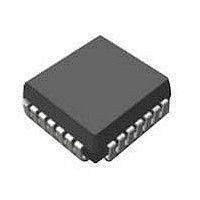AM29LV040B-70JC Spansion Inc., AM29LV040B-70JC Datasheet - Page 14

AM29LV040B-70JC
Manufacturer Part Number
AM29LV040B-70JC
Description
Flash Memory IC
Manufacturer
Spansion Inc.
Specifications of AM29LV040B-70JC
Memory Configuration
512K X 8
Ic Interface Type
Parallel
Access Time
70ns
Memory Case Style
PLCC
No. Of Pins
32
Mounting Type
Surface Mount
Peak Reflow Compatible (260 C)
No
Supply Voltage
3V
Lead Free Status / RoHS Status
Contains lead / RoHS non-compliant
Available stocks
Company
Part Number
Manufacturer
Quantity
Price
Part Number:
AM29LV040B-70JC
Manufacturer:
AMD
Quantity:
20 000
DQ7 or DQ6. See “Write Operation Status” for informa-
tion on these status bits.
Any commands written to the device during the
Embedded Program Algorithm are ignored. Note that a
hardware reset immediately terminates the program-
min g o pe ra ti on . T he B y te P ro gra m c om ma nd
sequence should be reinitiated once the device has
reset to reading array data, to ensure data integrity.
Programming is allowed in any sequence and across
sector boundaries. A bit cannot be programmed
from a “0” back to a “1”. Attempting to do so may halt
the operation and set DQ5 to “1”, or cause the Data#
Polling algorithm to indicate the operation was suc-
cessful. However, a succeeding read will show that the
data is still “0”. Only erase operations can convert a “0”
to a “1”.
Unlock Bypass Command Sequence
The unlock bypass feature allows the system to
program bytes to the device faster than using the stan-
dard program command sequence. The unlock bypass
command sequence is initiated by first writing two
unlock cycles. This is followed by a third write cycle
containing the unlock bypass command, 20h. The
device then enters the unlock bypass mode. A two-
cycle unlock bypass program command sequence is all
that is required to program in this mode. The first cycle
in this sequence contains the unlock bypass program
command, A0h; the second cycle contains the program
address and data. Additional data is programmed in
the same manner. This mode dispenses with the initial
two unlock cycles required in the standard program
command sequence, resulting in faster total program-
ming time. Table 4 shows the requirements for the
command sequence.
During the unlock bypass mode, only the Unlock
Bypass Program and Unlock Bypass Reset commands
are valid. To exit the unlock bypass mode, the system
must issue the two-cycle unlock bypass reset
command sequence. The first cycle must contain the
data 90h; the second cycle the data 00h. The device
then returns to reading array data.
Figure 1 illustrates the algorithm for the program oper-
ation. See the Erase/Program Operations table in “AC
Characteristics” for parameters, and to Figure 12 for
timing diagrams.
Chip Erase Command Sequence
Chip erase is a six bus cycle operation. The chip erase
command sequence is initiated by writing two unlock
cycles, followed by a set-up command. Two additional
unlock write cycles are then followed by the chip erase
command, which in turn invokes the Embedded Erase
algorithm. The device does not require the system to
preprogram prior to erase. The Embedded Erase algo-
rithm automatically preprograms and verifies the entire
14
D A T A
Am29LV040B
S H E E T
memory for an all zero data pattern prior to electrical
erase. The system is not required to provide any con-
trols or timings during these operations. Table 4 shows
the address and data requirements for the chip erase
command sequence. Note that the autoselect function
is unavailable when an erase operation is in progress.
Any commands wr itten to the chip dur ing the
Embedded Erase algorithm are ignored. Note that a
hardware reset during the chip erase operation imme-
diately terminates the operation. The Chip Erase
command sequence should be reinitiated once the
device has returned to reading array data, to ensure
data integrity.
The system can determine the status of the erase oper-
ation by using DQ7, DQ6, or DQ2. See “Write
Operation Status” for information on these status bits.
When the Embedded Erase algorithm is complete, the
device returns to reading array data and addresses are
no longer latched.
Figure 2 illustrates the algorithm for the erase opera-
tion. See the Erase/Program Operations tables in “AC
Note: See Table 4 for program command sequence.
Increment Address
Figure 1. Program Operation
in progress
Embedded
algorithm
Program
No
Command Sequence
21354E4 October 11, 2006
Write Program
Last Address?
Programming
from System
Verify Data?
Completed
Data Poll
START
Yes
Yes
No
















